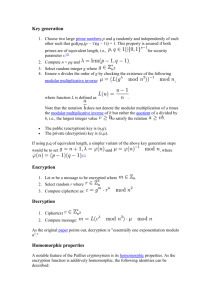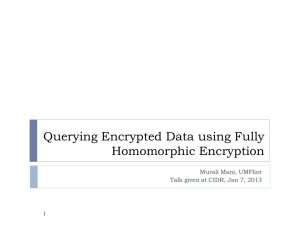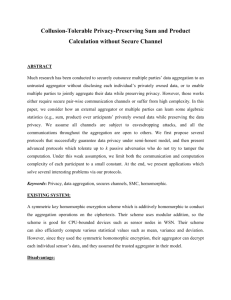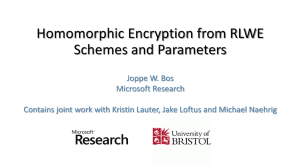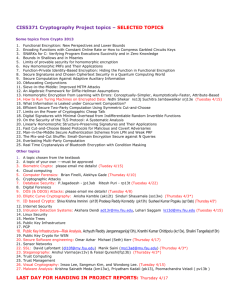Fully Homomorphic Encryption - Simons Institute for the Theory of
advertisement
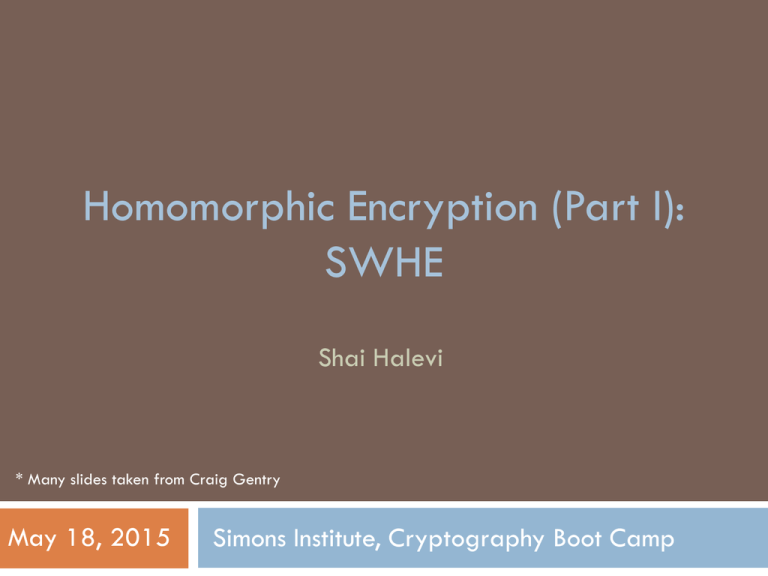
Homomorphic Encryption (Part I):
SWHE
Shai Halevi
* Many slides taken from Craig Gentry
May 18, 2015
Simons Institute, Cryptography Boot Camp
Computing on Encrypted Data
Can we delegate the processing of data,
without giving away access to it.
Encrypted Cloud Computing
The special sauce! For security
parameter λ, Eval’s running
should be Time(f)∙poly(λ)
“I want 1) the cloud to process my data
2) even though it is encrypted.
Run
Eval[ f, Encpk(x) ]
= Encpk[f(x)]
Encpk(x)
function f
This could be
encrypted too.
Alice
(Input: data x,
secret key sk)
f(x)
Encpk[f(x)]
Server
(Cloud)
Delegation: Should cost less for
Alice to encrypt x and decrypt f(x)
than to compute f(x) herself.
Homomorphic Encryption (HE)
Procedures: KeyGen, Encrypt, Decrypt, Eval
Semantic Security: same as for basic encryption
Correctness: For any function f in “supported” family F:
c1 ← Encpk(m1)
…
ct ← Encpk(mt)
c* ← Evalpk(f, c1, …, ct) Decsk(c*) = f(m1, …, mt)
Compactness: complexity of decrypting c* does not
depend on complexity of f
An Analogy: Alice’s Jewelry Store
Alice wants workers to assemble raw materials into jewelry
But Alice is worried about theft:
She wants workers to process raw materials without having access.
Alice puts raw materials in locked glovebox.
Workers assemble jewelry inside glovebox, using the gloves.
Alice unlocks box to get “results”.
Homomorphic Encryption
“Somewhat”
means it works for
some functions f
Somewhat
Homomorphic
Encryption (SWHE):
f
Enc[x]
Eval
Enc[f(x)]
Pre-2009 schemes were somewhat homomorphic.
Homomorphic Encryption
“Fully” means
it works for all
functions f
Fully Homomorphic
Encryption (FHE)
[RAD78, Gen09]:
f
Enc[x]
Eval
Enc[f(x)]
HE Security: A Paradox?
Cloud stores my encrypted files: pk, Encpk(f1),…, Encpk(fn).
Later, I want f3, but want to hide “3” from cloud.
I send Encpk (3) to the cloud.
Cloud runs Evalpk (F, Encpk(3), Encpk(f1),…, Encpk(fn)),
where F(n, {files}) is the function that outputs the nth file.
It sends me the (encrypted) file f3.
Paradox?: Can’t the cloud “see” it is sending the 3rd encrypted file?
By comparing the stored value Encpk(f3) to the ciphertext it sends?
Resolution of paradox:
Semantic security implies:
Many encryptions of f3,
Hard to tell when two ciphertexts encrypt the same thing.
Properties/Limitations of HE
Some Properties
Chosen-ciphertext security: HE is malleable by design,
standard CCA security cannot be achieved
Can
get CCA1other security notions (e.g. homomorphic sigs)
Multi-hop: Can we apply Eval to evaluated ciphertexts?
Usually
yes, but not inherently so
Function privacy: Does Evalpk(f,…) hide f?
Even
from an adversary that has the secret key?
This can be arranged
Malicious security: What if pk, c are malformed?
Secret-key vs. Public-key HE
A helpful aside: for homomorphic encryption,
public-key and secret-key are essentially the same
Theorem [R11]: There is an easy black-box transformation
from secret-key HE to public-key HE
Public key: ℓ random bits and their encryptions
𝑃𝐾 = 𝑏1 , 𝑐1 , … , 𝑏ℓ , 𝑐ℓ , 𝑐𝑖 = 𝐸𝑛𝑐𝑠𝑘 (𝑏𝑖 )
ℓ is chosen larger than the cipehrtext-size, ℓ ≫ |𝑐𝑖 |
To Encrypt a bit 𝜎, choose a random bit-string 𝑟 such
that ∑𝑟𝑖 𝑏𝑖 = 𝜎, output 𝑐 = ∑𝑟𝑖 =1 𝑐𝑖 = 𝐸𝑛𝑐(∑𝑟𝑖 𝑏𝑖 )
Transforming HE from SK to PK
𝑃𝐾 = 𝑏, 𝒄 , 𝑐𝑖 = 𝐸𝑛𝑐𝑠𝑘 (𝑏𝑖 )
𝑏 = ℓ ≫ |𝑐𝑖 |
Enc(𝜎): choose random 𝑟 ∈ 0,1
output
ℓ
s.t. 𝑟, 𝑏 = 𝜎
𝑐 = ∑𝑟𝑖 =1 𝑐𝑖 = 𝐸𝑛𝑐 𝑟, 𝑏
Correctness: immediate from additive homomorphism
Security: The transformation 𝑟 → 𝑐 is lossy
If
the 𝑐𝑖 ’s were encryptions of zero then secrecy of 𝜎
would follow from “leakage resilience” of inner-product
By security of the underlying secret-key scheme,
adversary cannot tell if the 𝑐𝑖 ’s are encryptions of zero
FHE Doesn’t Do Obfuscation
Obfuscation:
Difference between obfuscation and FHE:
In FHE, cloud computes Enc(P(x)), and it can’t decrypt to get P(x).
Barak et al: “On the (Im)possibility of Obfuscating Programs”
I give the cloud an “encrypted” program Enc(P).
For any input x, cloud can compute Enc(P)(x) = P(x).
Cloud learns “nothing” about P, except {xi,P(xi)}.
Certain types of obfuscation are impossible.
Garg et al: “Candidate Indistinguishability Obfuscation and
Functional Encryption for All Circuits”
Certain types of obfuscation seem possible (we have schemes).
FHE Doesn’t Do RAM
Circuits vs. RAMs:
Circuits are powerful: Circuit-size ≈ TM complexity.
But random-access machines compute some functions much faster
than a TM or circuit (Binary search)
Can’t do “random access” on encrypted data without leaking
some information (not surprising)
What we can do:
Oblivious RAM: But this is a very interactive protocol between
client and server where server can’t tell what client is computing
Use Obfuscation to do ORAM: Intuitively, obfuscation allows
addresses in memory to be revealed “noninteractively”.
FHE Doesn’t Do Multi-Key
Multi-Key FHE
Different
ci←
clients encrypt data under different FHE keys
Encpki(mi)
Later,
cloud “combines” data encrypted under different
keys to get c* ← Eval(pk1,…pkt,f,c1,…ct).
Can
decrypt c* to f(m1,…,mt) by pooling sk1,…sk
FHE doesn’t do this “automatically”.
But
there are some schemes that do this
Constructing SWHE
How to compute on encrypted data?
1.
Express functions to compute as a binary
circuit with +,×
That’s always possible
2.
Design a bit-encryption scheme that supports
addition, multiplication of encrypted bits
That’s the hard part
A Toy HE Scheme
(from American Scientist magazine)
Encryption: Double the plaintext. x → 2x
Decryption: Halve the ciphertext. x → x/2
About “Homomorphism”
Name inspired by ring-homomorphism
Ring of
plaintexts
+,×
Ring of
plaintexts
Enc
Commutative Diagram
Enc
Ring of
ciphertexts
⊞,⊠
Ring of
ciphertexts
About “Homomorphism”
Name inspired by ring-homomorphism
Ring of
plaintexts
Ring of
ciphertexts
Homomorphism should not be taken too literally
Else
Enc
zero-encryptions form a linear subspace (ideal)
Is it possible to hide such an ideal?
Some
attempts (e.g. Polly Cracker), but broken
Noisy Ciphertexts
Each ciphertext has some noise that hides the message.
Think: “hidden” error correcting codes…
If error is small, Alice can use knowledge of “hidden”
code to remove the noise.
If noise is large, decryption is hopeless even for Alice.
Example: SWHE over the Integers
Main Idea
Encryptions of 0 are something small and even
modulo a secret integer.
Secret key: large odd integer n
Public key: integers 𝑥𝑖 = 𝑞𝑖 𝑛 + 2𝑟𝑖 𝑖 , 𝑟𝑖 ≪ 𝑛
These
Encrypt: Subset-sum of 𝑥𝑖 ‘s, then add 𝑚 ∈ {0,1}
𝑐
are encryptions of 0
= ∑𝑖∈𝑆 𝑥𝑖 = ∑𝑆 𝑞𝑖 ⋅ 𝑛 + 2 ∑𝑆 𝑟𝑖 + 𝑚
Decrypt: 𝑐 𝑚𝑜𝑑 𝑛 = 2𝑟 + 𝑚, LBS is message 𝑚
ADD, MULT: sum/product over the integers
Security of SWHE with Integers
Reduction:
If
“approximate gcd” problem is hard, then the scheme is
semantically secure.
Approximate GCD Problem:
Given
many 𝑥𝑖 = 𝑞𝑖 𝑛 + 𝑟𝑖 (approx multiples of 𝑛), find 𝑛.
The Noise Problem
ADD: c = c1+c2.
Noise
of c is [c mod n] = [c1mod n] + [c2 mod n]
Unless this sum is bigger than n (decryption error).
MULT: c = c1∙c2.
Noise
[c mod n] is product of noises, unless product > 𝑛.
𝑞1 𝑛 + 𝑒1 𝑞2 𝑛 + 𝑒2 = 𝑞1 𝑞2 𝑛 + 𝑞1 𝑒2 + 𝑞2 𝑒1 𝑛 + 𝑒1 𝑒2
Function 𝑓: 𝑐 = 𝑓(𝑐1, … , 𝑐𝑡).
Noise
[𝑐 mod 𝑛] = f([𝑐𝑖 mod 𝑛]𝑖 ) – i.e., 𝑓 applied to noises.
Rough approximation:
Noise
magnitude increases exponentially with degree of 𝑓.
The Noise Problem Hurts Efficiency. Why?
Ciphertexts must be large to let noise “room to grow”.
Noise
grows exponentially with degree.
Bit-length
of noise grows linearly with degree.
Ciphertext
size grows linearly with degree.
Somewhat Homomorphic Encryption
Based on LWE
Focusing on the Gentry-Sahai-Waters scheme.
(Brakerski and Vaikuntanathan were the first to
construct HE based on LWE.)
Regev’s Encryption Scheme
KeyGen(1𝑛 ): Choose secret key 𝒕 = 1, 𝒔
Public
𝑡
key: 𝐵 ∈ 𝑍𝑞𝑚×𝑛 random except 𝐵 × 𝒕
∈ 𝑍𝑞𝑛
𝑞
Encrypt(𝐵, 𝜇 ∈ {0,1}): For random 𝒓 ∈ 0,1
“small”
𝑚
output
𝑞
2
𝐜 ← 𝜇, 0, … , 0 ⋅ + 𝑟 × 𝐵
Decrypt(𝒄, 𝒕): Compute
𝑞
2
𝑞
2
𝒄, 𝒕 = 𝜇 ⋅ + 𝒓 × 𝐵 × 𝒕 = 𝜇 ⋅ + “small” (mod q)
Recover
𝜇 as MSB
𝒄, 𝒕
𝑞
Properties of Regev’s Scheme
Vectors: Ciphertext 𝒄 and secret-key 𝒕 are vectors
over 𝑍𝑞 , the1st entry in t is 1
Small dot-product: If 𝒄 encrypts 𝜇 under 𝒕 then
𝑞
𝒄, 𝒕 𝑞 = 𝜇 ⋅ + small
2
Ciphertexts are pseudorandom: Under the hardness
of decision-LWE, ciphertext are indistinguishable
from uniform vectors over 𝑍𝑞
To
an attacker who doesn’t know the secret key
Homomorphic ADD in Regev
Additive Homomorphism: Add ciphertexts
If
𝒄𝒊 , 𝑡
𝑞
𝒄1 + 𝒄2 , 𝒕
𝑞
2
= 𝜇𝑖 ⋅ + smalli then
𝑞
𝑞
2
= 𝜇1 + 𝜇2 ⋅ + small
(if original small‘s were small enough)
Homomorphic MULT in Regev
Mulitplicative homomorphism: multiply cipehrtexts?
How
do you multiply vectors?
Tensor product? For 𝑎 = 𝑎1 , … , 𝑎𝑚 , 𝑏 = (𝑏1 , … , 𝑏𝑛 ),
the tensor is 𝑎 ⊗ 𝑏 = (𝑎1 𝑏1 , … , 𝑎𝑚 𝑏𝑛 )
Fact:
𝒄𝟏 ⊗ 𝒄𝟐 , 𝑡 ⊗ 𝑡 = 𝒄𝟏 , 𝑡 ⋅ 𝒄𝟐 , 𝑡 (mixed prod.)
𝒄𝟏 ⊗ 𝒄𝟐 can be seen as encrypting 𝜇1 ⋅ 𝜇2 under 𝑡 ⊗ 𝑡
Efficiency problem: MULT squares the dimension
Brakerski
and Vaikuntanathan made this work
Turn ciphertexts into matrices? Use matrix product
Matrix Version
st
(1
try)
KeyGen: As before, secret key 𝒕 = 1, 𝒔 ∈ 𝑍𝑞𝑛
Encrypt(𝜇 ∈ {0,1}): Choose 𝐶0 ∈ 𝑍𝑞𝑛×𝑛
Rows
are Regev-encryption of 0, 𝐶0 × 𝒕 = small
Output C = 𝜇 ⋅ 𝐼 + 𝐶0 (𝐼 is the identity)
Security: 𝐶0 is pseudorandom (hence also 𝐶)
Decryptt(C): Compute
𝒛 = 𝐶 × 𝒕 𝑞 = 𝜇 ⋅ 𝐼 + 𝐶0 × 𝒕 = 𝜇 ⋅ 𝒕 + small
Output
0 if 𝒛 is small, 1 if 𝒛 is close to 𝒕
Secret key 𝒕 is approximate eigenvector of 𝐶
Message
𝜇 is the corresponding eighenvalue
Homomorphism in Error-Free Setting
Ciphertext
Matrix
Message
Eigenvalue
Secret Key
Eigenvector
If 𝐶𝑖 × 𝒕 = 𝜇𝑖 ⋅ 𝒕 𝑚𝑜𝑑 𝑞
Then
𝐶1 + 𝐶2 × 𝒕 = 𝜇1 + 𝜇2 ⋅ 𝒕 (𝑚𝑜𝑑 𝑞)
And 𝐶1 × 𝐶2 × 𝒕 = 𝜇1 ⋅ 𝜇2 ⋅ 𝒕 (𝑚𝑜𝑑 𝑞)
Homomorphism with Error
st
(1
try)
𝐶𝑖 × 𝒕 = 𝜇𝑖 ⋅ 𝒕 + 𝒆𝒊 (𝑚𝑜𝑑 𝑞) for 𝑖 = 1,2
Addition: 𝐶1 + 𝐶2 × 𝒕 = 𝜇1 + 𝜇2 ⋅ 𝒕 + (𝑒1 + 𝑒2 )
Multiplication: 𝐶 × = 𝐶1 × 𝐶2
𝐶
×
× 𝒕 = 𝐶1 × 𝐶2 × 𝒕
= 𝐶1 × 𝜇2 ⋅ 𝒕 + 𝒆𝟐
New Noise
= 𝜇2 ⋅ 𝐶1 × 𝒕 + 𝐶1 × 𝒆𝟐
= 𝜇2 ⋅ 𝜇1 ⋅ 𝒕 + 𝑒1 + 𝐶1 × 𝒆𝟐
= 𝜇1 ⋅ 𝜇2 ⋅ 𝒕 + 𝜇2 ⋅ 𝒆𝟏 + 𝐶1 × 𝒆𝟐 (𝑚𝑜𝑑 𝑞)
Controlling the Noise
𝐶 × × 𝒕 = 𝜇1 ⋅ 𝜇2 ⋅ 𝒕 + 𝜇2 ⋅ 𝒆𝟏 + 𝐶1 × 𝒆𝟐
Keep messages 𝜇 small:
Easy!
New Noise
Restrict messages to {0,1} and use NAND gates
Keep ciphertext entries small:
we “flatten” the product matrix 𝐶 × to make its
entries small?
Can
Gadget for Flattening
Use “Gadget Matrix” 𝐺 ∈ 𝑍𝑞𝑚×𝑛 with associated
“inverse transformation” 𝐺 −1 : 𝑍𝑞𝑚×𝑛 → 𝑍𝑞𝑚×𝑚
Used
for “lattice trapdoors” [A99,…,MP12]
For any 𝐶 ∈ 𝑍𝑞𝑚×𝑛 :
𝐺
−1
𝐶 ∈ 𝑍𝑞𝑚×𝑚 is small
𝐺
−1
𝐶 ×𝐺 =𝐶
Example of a Gadget Matrix
𝐺 −1 𝐶 breaks each entry in C to its bits
7
2
4
1 1 1 1 0 0
5 ⟹ 0 1 0 1 0 1
⋱
⋱
0 0 1 0 0 1
1 3
𝐺 has powers of two, G =
4
2
1
0
0
0
0
0
0
4
2
1
Modified Matrix Encryption
Encryption of 𝜇 is a matrix 𝐶 ∈ 𝑍𝑞𝑚×𝑛 such that
𝐶 × 𝒕 = 𝜇 ⋅ (𝐺 × 𝒕)+ 𝑒
𝒕′
Easy to modify Enc to get this form
Set
𝐶 = 𝜇 ⋅ 𝐺 + 𝐶0 rather than 𝐶 = 𝜇 ⋅ 𝐼 + 𝐶0
Security follows from LWE as before
Additive homomorphism works just as before
Homomorphic Multiplication
𝐶𝑖 × 𝒕 = 𝜇𝑖 ⋅ 𝒕′ + 𝒆𝒊 for 𝑖 = 1,2 (𝒕′ = 𝐺 × 𝒕)
Set 𝐶 × = 𝐺 −1 (𝐶1 ) × 𝐶2
𝐶 × × 𝒕 = 𝐺 −1 𝐶1 × 𝐶2 × 𝒕
= 𝐺 −1 𝐶1 × 𝜇2 ⋅ 𝒕′ + 𝑒2
= 𝜇2 ⋅ 𝐺 −1 𝐶1 × 𝐺 × 𝒕 + 𝐺 −1 𝐶1 × 𝒆𝟐
= 𝜇2 ⋅ 𝐶1 × 𝒕 + 𝐺 −1 𝐶1 × 𝒆𝟐
Homomorphic Multiplication
𝐶𝑖 × 𝒕 = 𝜇𝑖 ⋅ 𝒕′ + 𝒆𝒊 for 𝑖 = 1,2 (𝒕′ = 𝐺 × 𝒕)
Set 𝐶 × = 𝐺 −1 (𝐶1 ) × 𝐶2
𝐶 × × 𝒕 = 𝐺 −1 𝐶1 × 𝐶2 × 𝒕
= 𝐺 −1 𝐶1 × 𝜇2 ⋅ 𝒕′ + 𝑒2
= 𝜇2 ⋅ 𝐺 −1 𝐶1 × 𝐺 × 𝒕 + 𝐺 −1 𝐶1 × 𝒆𝟐
= 𝜇2 ⋅ 𝐶1 × 𝒕 + 𝐺 −1 𝐶1 × 𝒆𝟐
= 𝜇2 ⋅ 𝜇1 ⋅ 𝒕′ + 𝒆𝟏 + 𝐺 −1 𝐶1 × 𝒆𝟐
= 𝜇1 𝜇2 ⋅ 𝒕′ + 𝜇2 ⋅ 𝒆𝟏 + 𝐺 −1 𝐶1 × 𝒆𝟐 (𝑚𝑜𝑑 𝑞)
small
New Noise
Summary of GSW
Encryption of 𝜇 is 𝐶 × 𝒕 = 𝜇 ⋅ 𝒕′ + 𝒆 (𝒕′ = 𝐺 × 𝒕)
Additive homomorphism: 𝐶 + = 𝐶1 + 𝐶2
New
noise is 𝒆+ ≤ 𝒆𝟏 + 𝒆𝟐 ≤ 2 ⋅ max( 𝒆𝒊 )
Multiplicative homomorphism: 𝐶 × = 𝐺 −1 (𝐶1 ) × 𝐶2
New
noise is 𝒆× ≤ 𝜇2 ⋅ 𝒆𝟏 + 𝑚 ⋅ 𝒆𝟐
≤ 𝑚 + 1 ⋅ max(|𝒆𝒊 |)
Somewhat homomorphic:
can
evaluate circuits with log 𝑚+1 𝑞 levels
Questions?
